Rotherham
The club was formed as Thornhill United. For many years the leading team in the area wasRotherham Town, who spent three seasons in the Football League while Thornhill United were still playing in the Sheffield & Hallamshire League. By the turn of the century, however, Rotherham Town had resigned from the Football League and briefly gone out of business before joining the Midland League. Meanwhile, Thornhill's fortunes were on the rise to the extent that in 1905 they laid claim to being the pre-eminent club in the town and changed their name to Rotherham County. For a period both clubs competed in the Midland League, finishing first and second in 1911-12. When the Great War ended, it was decided to extend The Football League by creating four new places in Division Two. Rotherham County, who had been champions of the Midland League in 1915 before the competition was suspended, were elected to one of the vacancies.
The Second Division was rather too tough for the Yorkshire side and in 1923 they were relegated to Division Three (North). In 1925 the club finished bottom and had to apply for re-election. Rotherham Town were themselves struggling and it was clear that to have two professional clubs in the town was not sustainable. Talks had begun in February 1925 and in early May the two clubs merged to form Rotherham United. Days later the reformed club was formally re-elected under its new name.
In a new amber and black strip, United may have begun with optimism but the new club fared little better than the old one. The now familiar red and white was adopted around 1928 but there was no improvement in the club's fortunes: in 1931 they again had to apply for re-election. Immediately after the Second World War things looked up. After adopting Arsenal-style white sleeved shirts, United finished as runners-up three time in succession between 1947 and 1949 and then were champions of Division Three (North) in 1951.
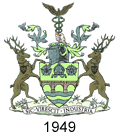 The team added the coat of arms of Rotherham Borough to their shirts in 1949. (A crest had earlier appeared in the Thirties but as this predates the granting of the arms to Rotherham Borough Council it is not possible to verify them.)
The team added the coat of arms of Rotherham Borough to their shirts in 1949. (A crest had earlier appeared in the Thirties but as this predates the granting of the arms to Rotherham Borough Council it is not possible to verify them.)
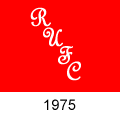 In 1955 they finished third in Division Two, the closest they have ever come to winning promotion to the top level. The club held on to its place in Division Two until 1968 and then went into a decline that took them down to Division Four in 1973. In 1975 they were promoted back to the Third Division and for the following seasons a typical monogramme of the period was introduced.
In 1955 they finished third in Division Two, the closest they have ever come to winning promotion to the top level. The club held on to its place in Division Two until 1968 and then went into a decline that took them down to Division Four in 1973. In 1975 they were promoted back to the Third Division and for the following seasons a typical monogramme of the period was introduced.
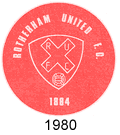 A new club crest was introduced in 1980, a season that ended with the Third Division championship and a brief return to Division Two. The central motif of the badge was a large "X" representing the sails of a windmill, inspired by the team's nickname (The Millers). The inclusion of a date - 1884 - is a bit of a puzzle as it does not represent the year that United was formed nor the formation of the two clubs that
A new club crest was introduced in 1980, a season that ended with the Third Division championship and a brief return to Division Two. The central motif of the badge was a large "X" representing the sails of a windmill, inspired by the team's nickname (The Millers). The inclusion of a date - 1884 - is a bit of a puzzle as it does not represent the year that United was formed nor the formation of the two clubs that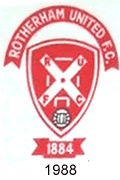 merged in 1925. It appears to be a reference to the year that a team from the town entered the FA Cup. The team in question was Rotherham FC whose details are found in the Rotherham Townsection.
merged in 1925. It appears to be a reference to the year that a team from the town entered the FA Cup. The team in question was Rotherham FC whose details are found in the Rotherham Townsection.
By 1988, United were again in Division Four but won the Division title at the first attempt. The club crest was by now slightly more elaborate than the original version. In 1999 the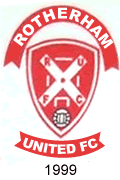 confusing date was removed and the lettering rearranged.
confusing date was removed and the lettering rearranged.
During the 1990s Rotherham were promoted and relegated between the lowest two divisions with some regularity but successive promotions in 2000 and 2001 took them back to what had now become Nationwide Division One.
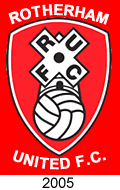 In 2005 a smart new version of the crest was introduced.
In 2005 a smart new version of the crest was introduced.
Financial problems continued to plague the club and in 2006 they narrowly avoided going into liquidation but lost their League One status as a result of being docked ten points. In March 2008, Rotherham, now playing in League Two (the lowest tier of the Football League) went into financial administration again, a decision that cost them ten points and any chance of reaching the play-offs. A number of bidders came forward but the threat of legal action to prevent the sale by the club's landlords, the Booth family, put at least one Russian billionaire buyer off. Ken Booth, the club's wealthy Honorary President and landlord, wanted to preserve his family's perks, which included access to the club physiotherapist, free tickets, VIP access to games and free tickets to the FA Cup final. As a result, the club's new owner, Tony Stewart, decided to sever connections with the Booth family, quit Millmoor and play their home games at the Don Valley Stadium in Sheffield until new facilities could be built in Rotherham. After the club failed to agree a Company Voluntary Agreement with its creditors, who rejected an offer of 5p in the pound, the Football League imposed a 17-point penalty at the beginning of the 2008-09 season and threatened the club with expulsion if they failed to return to Rotherham within four years.
In January 2010 the club announced that their new stadium would be built on the site of the former Guest and Chrime's Foundry in the town centre.
